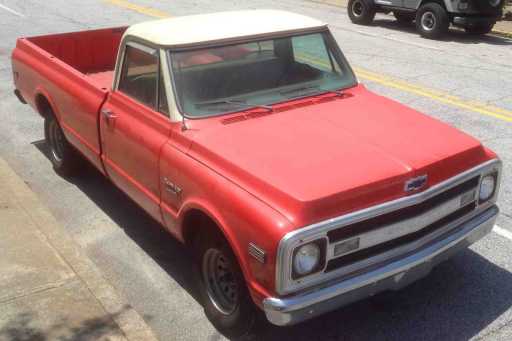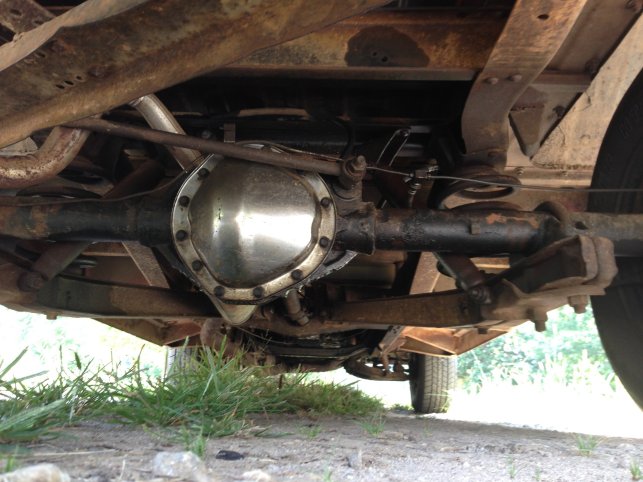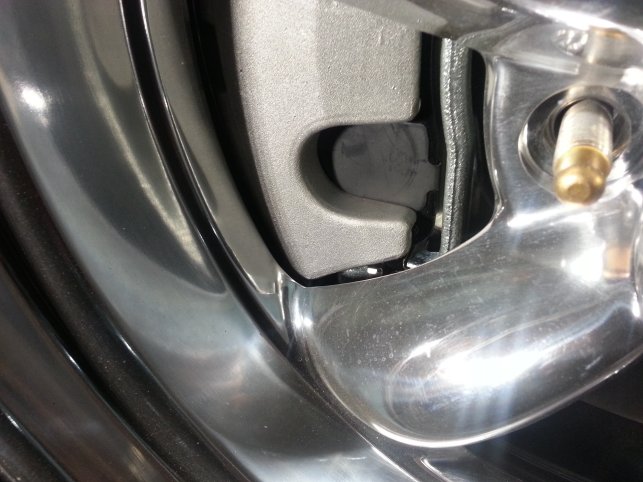
Before Side View
The truck came with the original brakes & suspension. 1970 was the last year that Chevy had 4 wheel drum brakes on the C10. The springs had probably sagged an inch or 2. When I bought my truck, the brake system was very bad.

Original Rear Suspension
The rear brake line "T" is not
supported & the center driveshaft
support bushing is missing.
I replaced all the pivots, bushings, shocks and springs in the suspension, and lowered the truck about 2 inches. I changed over to 4 wheel disc brakes. There are parts and kits to fit the front disc brakes from a 1971-72 C10, but I wanted better brakes than that. By lowering it 2", adding anti-roll bars, and putting on much better brakes, I hoped to bring the handling closer to modern standards.
The front suspension was lowered 2" using modular front spindles from Classic Performance Products (CPP) with 1970 ball joints & tie rod ends. When going to this dropped spindle, the wheel needs to be at least 16" to clear some of the front suspension. I needed at least that size wheel to clear the brakes I planned to put on the front, so I was OK. The front springs are stock height - the lowering all comes from the hub mounting position on the front spindles. Stock height Bilstein B6 Series 4600 shocks are used in front.
Dave Caffey of Contemporary Auto Restoration recommended replacing the front control arms because the original upper arm can get cracks with brake loading. So I used upper and lower control arms from PB Fab. I got a lower arm that moves the ball joint forward 1". This gives better caster to keep the steering self-centering, and moves the wheels about 1/2" forward to better center them in the front wheel wells.
From the factory, there was an optional front anti-roll bar. Very few vehicles were sold with this, and mine did not have one. So an anti-roll bar from Addco was added. These mount to factory mounting points on the lower sub-frame and the lower control arms.
The front brakes were replaced with 325mm (12.8") diameter disk brakes. The rotors and calipers are from a C6 (2006-2013) Corvette. Kore3 drills the rotors for the 5 on 5" wheel bolt pattern and provides a custom caliper mounting plate and hub. I'm using Hawk HPS brake pads. These brakes need at least a 17" wheel, but clearance between the caliper and wheel is tight, and not every 17" wheel will clear. My 17" front wheels need a 1/2" spacer to clear the hub & brake calipers.
A new power steering box was installed during the work on the front suspension and steering. This has a slightly faster steering ratio.

Front Brake Clearance - with
1/2" wheel spacer. 1/4" needs
to be machined off the wheel studs
to fit acorn-style lug nut.
The rear suspension uses coil springs that are 2 inches shorter than stock. The rear shocks are KYB Excel-G for a 2" lowered suspension. The rear suspension has an anti-sway bar added. The stock Panhard bar has been replaced with an adjustable one from Early Classic.
The rear axle shafts were changed during the install to get a wheel bolt pattern of 5 lugs on a 5" diameter. The 67-69 models had a narrower rear axle, with 6 wheel lugs on a 5.5" pattern. In 71-72, the axle was wider and had 5 lugs on a 5" pattern. During 1970, all of the bolt patterns were 6 lugs on a 5.5" pattern, but some had a wide axle and some had a narrow axle. Mine has a wide rear axle, so axle shafts from Moser for a 71-72 model gives a 5 bolt on 5" pattern.
I'm using a Wilwood D154 disc brake kit with internal drum parking brakes. These have 12.19" diameter rotors. A cable from Lokar connects the original emergency brake pedal to the Wilwood rear parking brakes.
The pickup truck came with a vacuum booster, since it had power brakes. This was replaced with an 8" diameter dual diaphragm unit. The master cylinder and adjustable proportioning valve are from Wilwood.
The brake lines were replaced with steel hard lines since they are old. Flexible braided stainless steel brake lines are used at all 4 wheels, although a rubber flex line is still used to go from the rear frame to the rear axle.
Factory Settings:
For modern driving, getting the camber between 0 to -0.25 and getting the caster to about 6 degrees would be better. I can't currently get the alignment to what I want. The front camber with all the shims removed is about +1 to +2 degrees. On the driver's side, the upper control arm hits the flange on the frame at 1.8 degrees. With my lower control arms with the ball joint mount 1" forward, I get 6 to 7 degrees of caster, which is what I want. If I got upper control arms that are about 1/2" shorter or lower control arms that are 1/2" longer, this would likely allow me to get the camber to where I want it to be. But since the handling and steering feel good and I am not road racing, I'm happy with the front alignment.
My settings: